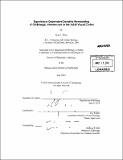Experience-dependent dendrite remodeling of GABAergic interneurons in the adult visual cortex
Author(s)
Chen, Jerry L.
DownloadFull printable version (7.690Mb)
Other Contributors
Massachusetts Institute of Technology. Dept. of Biology.
Advisor
Elly Nedivi.
Terms of use
Metadata
Show full item recordAbstract
An ever increasing amount of evidence is demonstrating that structural plasticity is a diverse and ongoing feature that contributes to plasticity in the adult brain. It was previously shown that dendritic arbors of inhibitory interneurons in superficial layer 2/3 can remodel in the adult cortex. Here, we investigated the role of these structural rearrangements during experience-dependent adult plasticity. Using in vivo two photon imaging, we monitored intemeuron dendritic branch tip remodeling in response to changes in visual experience in the adult mouse visual cortex. We find that branch tip dynamics are induced by novel experiences in a stimulus-specific manner. Visual deprivation produces rearrangements that are circuit-specific and are different for branch tips extending into LI or L2/3. The weakening of dendritic input onto these cells functions to reduce levels of inhibition in local cortical circuits. This reduced inhibitory tone provides more salience to remaining instructive input, allowing more structural and functional adaptations to occur. In order to better understand how synaptic plasticity accompanies these dendritic arbor rearrangements as well as other forms of structural plasticity, we developed a method to simultaneously monitor structural and synaptic dynamics in the mammalian brain using in vivo two-photon microscopy. Structural and synaptic components can be labeled in cortical neurons of mice in a cell type and laminar specific manner through co-injection of independent lentiviral vectors at a late embryonic or early postnatal age. We demonstrate that excitatory and inhibitory post-synaptic densities can be visualized by tagging fluorescent proteins to PSD95 and Gephyrin, respectively. Finally, we show that the fluorescent proteins, Teal and Venus, can be simultaneously excited and spectrally resolved through linear unmixing so that individual structural and synaptic components can be identified and followed over time. Through this approach, the relationship between synaptic and structural plasticity can be studied in the living brain.
Description
Thesis (Ph. D.)--Massachusetts Institute of Technology, Dept. of Biology, 2010. Cataloged from PDF version of thesis. Includes bibliographical references (p. 85-97).
Date issued
2010Department
Massachusetts Institute of Technology. Department of BiologyPublisher
Massachusetts Institute of Technology
Keywords
Biology.